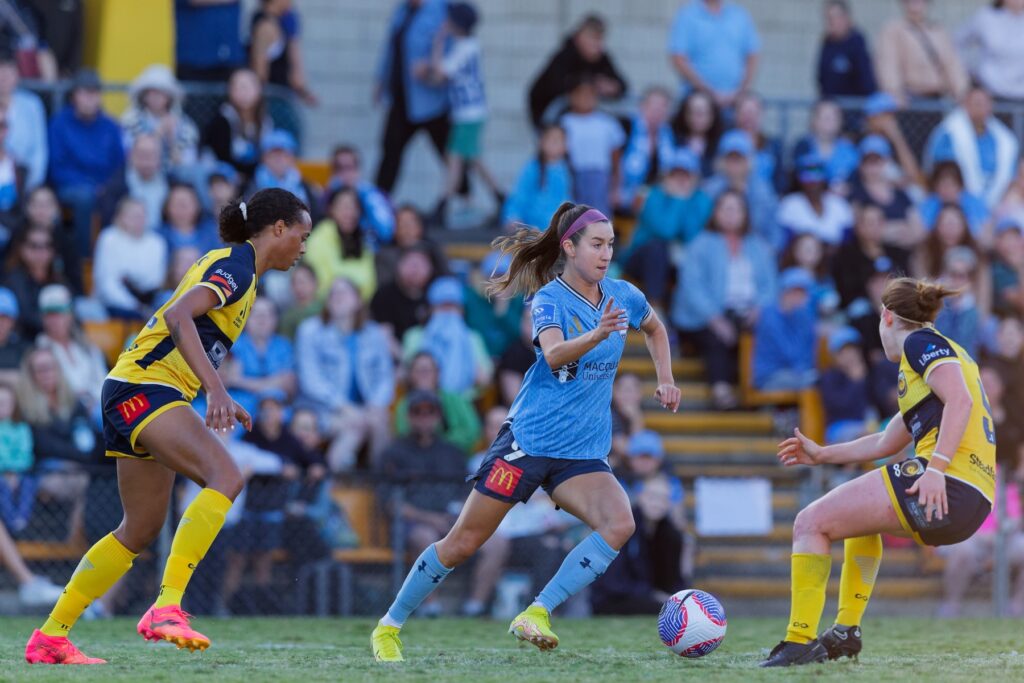
As the A-League Women’s Grand Final approaches and season comes to an end, it is a time to reflect on a season of incredible growth and broken records.
Similarly to the National Women’s Soccer League (NWSL) post-2015 Women’s World Cup, there was a popularity boost that translated into increased attendances and revenue for the league.
However, as the NWSL continued to rapidly develop, it seems as if the Liberty A-League struggled to consistently grow after a fantastic first round showing that involved a record-breaking 11,471 crowd for the Sydney Derby.
In the top 10 attendances of the regular season, eight feature games played before the new year despite the Matildas set to sell out a 14th consecutive home match before the Olympics commence in July.
The Liberty A-League crowd average is a little over 2,200 per match, which is a great benchmark for future growth but doesn’t do the participation and momentum justice.
The NWSL is a great case study to look at, with the league being formed only 12 years ago in 2012 and its first season started in the April of 2013.
In its formative years, the NWSL averaged an attendance 4,270, with a high of 17,619. A decent foundation but plenty of room to improve in the world’s biggest sporting market.
It wasn’t until the 2015 season where the league was forced into a shortened schedule and some early-season roster instability due to the 2015 FIFA Women’s World Cup in Canada.
The World Cup, which was won emphatically by the USWNT also provided invaluable exposure to the NWSL, which was credited with boosting attendance numbers across the league.
Instantly, teams such as Seattle and Washington who averaged 3,500 crowds per game were selling upwards of 6,000 to their next home game, an immediate resurgence.
So what did the NWSL do to fast-track growth using the World Cup?
Ticket prices
The NWSL, immediately after the 2015 Women’s World Cup pledged to keep the ticket prices consistent within teams, as it sat at $10-$15 USD (AUD $15-$23) across the league.
It was extremely cheap in a saturated and quite expensive US Sports market that allowed the league to use it as a point of difference.
It’s a simple solution that Melbourne City coach Dario Vidosic hinted at for this weekend’s Grand Final in his recent press conference.
Vidosic claimed that “If it was up to him, everyone would be let in for free for Saturday’s final.”
This is simply to create an exciting atmosphere that legitimises the league’s biggest game of the year on a national stage.
Breakaway from Men’s competition
NWSL Commissioner Jessica Berman made an extremely interesting point about the NWSL being its own entity.
Speaking to reporters at the Financial Times’ Business of Football summit in London, Berman said the “superpower” of the NWSL was its “independence” – notably from men’s clubs and leagues, which is not the case in Europe or Australia.
It certainly isn’t an overnight fix by any means but allowing the A-League Women’s to run separately from the A-League Men’s, even if it is just ownership could provide a difference that attracts more fans.
Maintaining local star players
Even in it’s infancy, the NWSL were able to show off USWNT stars like Lynn Williams, Megan Rapinoe and Alex Morgan during their ‘Golden Era.’
It collectively brought in more fans to the stands and increased the league’s exposure in the mainstream media.
It certainly isn’t as easy as that when the prospect of playing for more money and exposure in the US or Europe is a possibility now, but Cortnee Vine provides a great example of a star Matilda willing to be the face of the league to inspire young girls.
If the league are able to keep hold of exciting prospects like Daniela Galic or legends like Michelle Heyman for a few years, it would benefit the league greatly as an entertainment product.
Providing a great fan experience
There was an onus on the NWSL clubs and the league itself to make sure matchdays are an experience that brings fans back.
Two clubs in particular Angel City and San Diego Wave fans host tailgates pre-game near the stadium for anyone to join on top of other activations inside the stadium to connect fans closer to the team.
The WSW Women’s team are a fantastic example of an effort to build support, with their Wander Women program, school clinics, fan interactions and their own social media channels helping them grow slowly but surely.
It’s time the others follow suit in a collective attempt to maximise exposure.
To conclude, the NWSL used the 2015 World Cup as leverage to strike a quick deal with Fox Sports to broadcast 15 games for the rest of that season, cashing in on the national team’s success.
Now it boasts the biggest ever Women’s football media deal in history, with the recent four-year $240 million USD ($324 million AUD) domestic broadcast deal across four major streaming and cable partners.
It will be extremely interesting to see the direction the Liberty A-League takes before it renews its broadcast deal in 2026 as it simply cannot waste this golden opportunity it was presented.





















